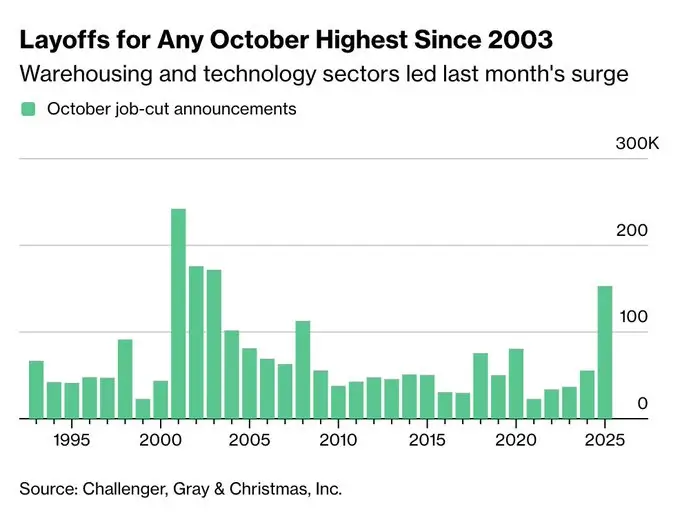October 2025 witnessed the worst month for job cuts in over two decades, with layoffs surging across multiple sectors. Tech giants, financial services firms, and healthcare institutions made significant cuts, reflecting ongoing economic uncertainty. The surge underscores broader challenges in the U.S. labour market.

October 2025 has been a devastating month for the U.S. job market, with layoffs reaching a 22-year high, affecting workers across industries. More than 150,000 jobs were cut in the month, marking the worst October since the early 2000s. This surge in layoffs highlights the economic turbulence and growing uncertainties in key sectors like technology, finance, and healthcare.
Massive Layoffs Across Multiple Sectors
October’s surge in job cuts was driven by layoffs in a variety of industries, but the tech and financial sectors bore the brunt of the cuts. According to data from Challenger, Gray & Christmas, a firm that tracks job cuts, over 150,000 layoffs were announced in October alone. This is the highest monthly total since 2003.
Tech Industry Takes the Biggest Hit
The technology sector, once a leader in job creation, experienced the largest wave of layoffs, contributing to nearly 40% of all job cuts in the month. Major companies such as Meta, Amazon, and Google announced substantial workforce reductions.
Meta, for instance, laid off over 20,000 employees, following a similar pattern set in previous months. The layoffs come after a period of rapid expansion during the pandemic, which saw tech firms hiring aggressively to meet the surge in online demand. However, the sector is now facing a slowdown in growth, compounded by rising competition and market saturation.

Financial Services Feeling the Pressure
The financial services industry also experienced a significant rise in layoffs. Major firms like Goldman Sachs and JPMorgan Chase reduced their workforces in response to volatile financial markets and a cooling economy.
The investment banking sector, which boomed during the pandemic, is now facing lower demand for its services due to changing interest rates and market instability. Reports suggest that 8,000 layoffs were attributed to this sector alone, marking a 23% increase compared to the previous month.
Healthcare and Retail Cutbacks
Even industries that were traditionally considered more recession-resistant, such as healthcare, saw job cuts in October. As healthcare providers navigate challenges such as rising costs and decreasing reimbursement rates, many hospitals and long-term care facilities reduced staffing in non-clinical roles.
Similarly, the retail sector, still adjusting to the post-pandemic economy, also faced large layoffs, particularly from companies struggling with inflation and changing consumer spending patterns.
Why Are Layoffs So High in 2025?
Economic Uncertainty and Rising Costs
At the core of these layoffs is ongoing economic uncertainty. The U.S. economy, which had made significant strides toward recovery after the pandemic, now faces inflationary pressures, rising interest rates, and supply chain disruptions. As companies seek to preserve profitability in an increasingly challenging environment, cost-cutting measures, including layoffs, have become more common.
While inflation has moderated in recent months, it remains a concern for many businesses, particularly those in sectors with thin profit margins, such as manufacturing and retail. Companies are cutting back on staff to offset increased operating costs and mitigate potential losses.
Automation and Technological Advancements
Another major factor driving layoffs is the growing reliance on automation and artificial intelligence (AI). Many companies, especially in the technology and finance sectors, are streamlining operations by adopting AI solutions to replace human labour.
This trend has been particularly evident in industries that have historically relied on large workforces for tasks like data entry, customer service, and manual labour.
Post-Pandemic Adjustments
The pandemic led to a period of rapid hiring across multiple sectors, especially in tech and e-commerce. However, as consumer demand has stabilised post-pandemic and remote work becomes more standardised, companies are now reassessing their workforces.
Many firms are finding that they overhired during the crisis and are now adjusting their staff numbers accordingly.
The Global Picture: Layoffs Beyond the U.S.
While the surge in job cuts has been particularly dramatic in the U.S., global layoffs have also been on the rise. In Europe, particularly in countries like Germany and the UK, companies in manufacturing and tech have announced significant job cuts in recent months.
The European Union has also seen a rise in layoffs due to the economic impact of the energy crisis and geopolitical tensions. In India, where the tech sector has been a major source of employment, firms such as Infosys and Wipro have followed similar trends, with mass layoffs expected as demand for IT services begins to taper off.
These global trends point to an interconnected economic system, where challenges in one region can quickly spill over to others.

Impact on Job Seekers and the Broader Economy
The surge in job cuts is not only affecting workers who are losing their jobs but is also having broader implications for the economy as a whole.
Unemployment and Consumer Confidence
The unemployment rate in the U.S. has remained low, but the sheer volume of job cuts in October raises concerns about future layoffs. As more people lose jobs, there is a risk that consumer confidence will decline. If individuals are uncertain about their job security, they are less likely to spend, leading to a potential slowdown in economic growth.
In particular, workers who were employed in industries heavily reliant on tech and finance may face greater challenges in re-entering the workforce. The layoffs in those sectors often require workers to shift their skills, and upskilling or reskilling may be necessary for those seeking new employment.
Growing Inequality
As layoffs surge, inequality in the job market may widen. Workers in industries that are heavily impacted, such as manufacturing and retail, are often left with fewer job options compared to those in higher-skilled, tech-focused positions. These layoffs also disproportionately affect lower-wage workers, further exacerbating existing income inequality.
The Role of Government and Policymakers
Policymakers are now facing increasing pressure to address the underlying issues affecting the economy. While the Federal Reserve and other regulatory bodies have worked to curb inflation through interest rate hikes, their efforts may not be enough to stem the tide of layoffs.
Economic recovery may require additional support for industries that are struggling, as well as stimulus packages aimed at revitalising the job market.
Related Links
How to Add $100s to Your Social Security Benefits Every Month – A Must-Know Tip
Mark Your Calendar: U.S. Banks, Including Bank of America, Shut Down for Veterans Day
Looking Ahead: What Does the Future Hold?
The outlook for the job market remains uncertain, especially as many of the underlying challenges continue to affect businesses. While layoffs are expected to continue in certain sectors, industries like green energy, healthcare, and logistics are showing strong signs of growth, providing some hope for job seekers in these fields.
As the economy continues to adjust to post-pandemic conditions, both companies and workers will need to be flexible. The trend towards automation and AI is unlikely to slow down, but businesses can find ways to balance technology with human capital to ensure that workers remain an integral part of their operations.
A Changing Job Market
October 2025 stands as a stark reminder of the ongoing volatility in the U.S. job market. While the layoff announcements surge may reflect a short-term adjustment to current economic conditions, the long-term effects could be felt for years to come.
Understanding the reasons behind these layoffs and the evolving nature of the workforce will be essential for navigating the future of work in America.





